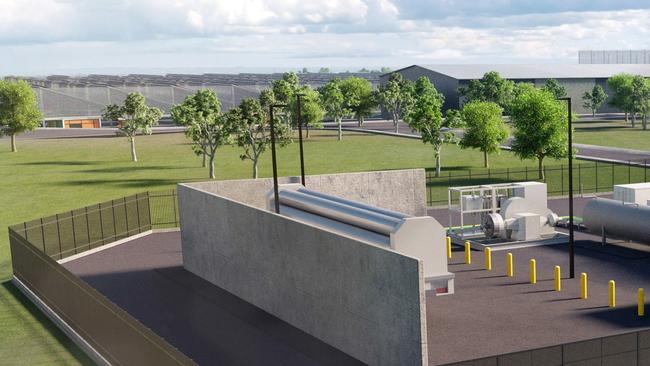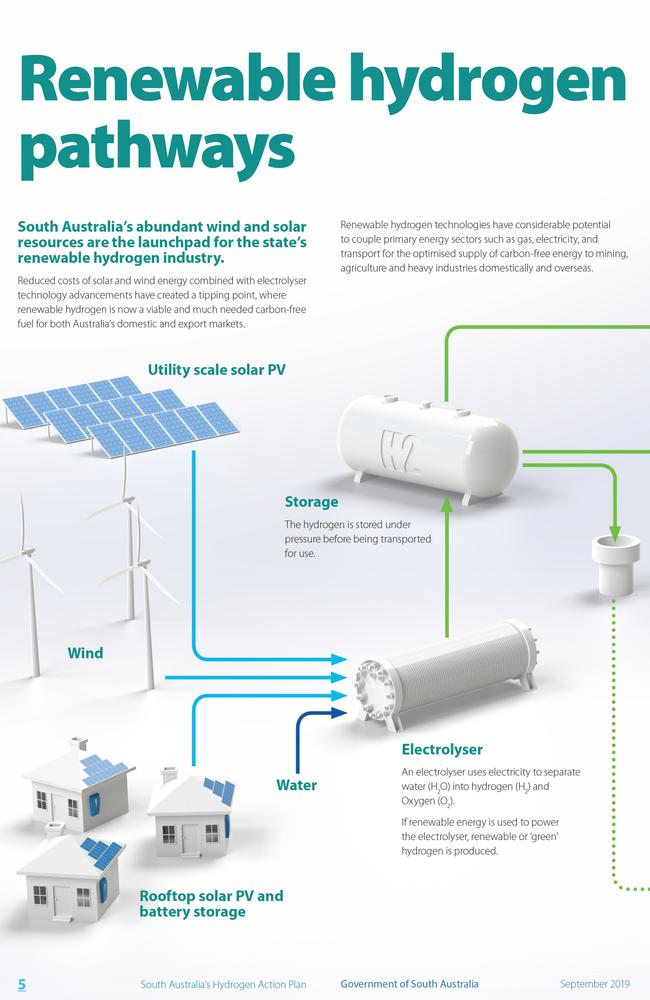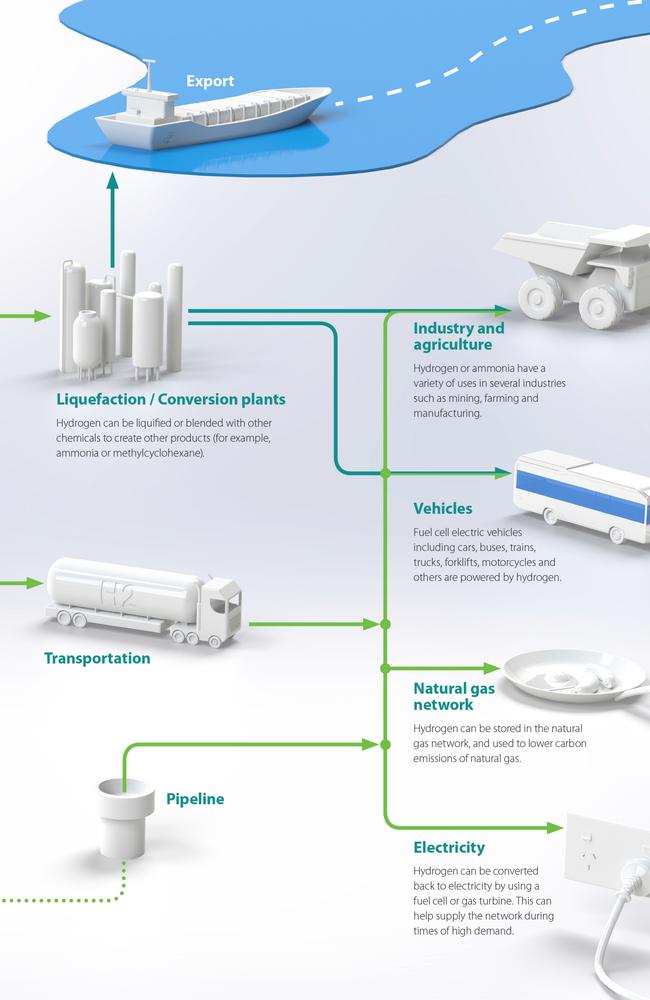Hydrogen fuel to be made in South Australia from renewable energy sources and exported to the world
Shipping sunshine is the state’s next growth industry, as we turn our abundant renewable energy into hydrogen fuel and sell it to the world. HOW IT WORKS

SA News
Don't miss out on the headlines from SA News. Followed categories will be added to My News.
- SA renewable energy use rises past 50 per cent
- Thousands rally for climate change action
- Get more from your digital subscription
An ambitious and lucrative plan to power South Australia’s economy and energy supply through hydrogen will be revealed today by Premier Steven Marshall.
The State Government will release its vision to create thousands of jobs and billions of export dollars, at an international hydrogen safety conference in Adelaide.
The versatile “fuel of the future” can replace natural gas for energy, and diesel in transport and industry. The SA Hydrogen Action Plan will scale up renewable hydrogen production and identify ideal locations for further investment, including facilities and infrastructure.
It states that SA can expect to secure “a substantial share” of an estimated $1.7 billion per annum injection into the national economy and 2800 jobs by 2030. That rises to a share of $4.3 billion and 7142 jobs by 2040.
Video: Department of Industry, Innovation and Science
Excess electricity from renewables such as wind and solar cannot be stored, but hydrogen creates an opportunity to store cheap energy in bulk while batteries fix short-term gaps.
“We welcome new industries that build on our natural advantages,” Premier Marshall said. “This initiative will drive the export of hydrogen from South Australia both interstate and overseas, bolstering our economy, and presenting future job opportunities.”
Hydrogen is also better than batteries when it comes to storage, because it is both light and stable in the long-term.

Minister for Energy and Mining Dan van Holst Pellekaan said the plan builds on the state’s leading role in hydrogen and renewable energy.
“This initiative fits in perfectly with our plan to help deliver more reliable, more affordable and cleaner energy for our state,” he said.
“It’s likely that nowhere else in the world is as well positioned as South Australia to produce, consume and export 100 per cent green hydrogen.
“Some of our longest-standing and closest trading partners are signalling that they will need hydrogen to make their energy transitions over coming decades, and we want to make the most of that growth opportunity by becoming a hub for the export of renewable energy.”


Export markets are opening up in Korea, Japan, China and Singapore, countries which have expressed their intentions to decarbonise.
Japan’s Hydrogen Strategy commits the nation to becoming “the first country in the world to realise a hydrogen-based society”. The Tokyo 2020 Olympics will showcase hydrogen to the world.
Similarly, Korea’s Roadmap and Hydrogen Economy Act outlines a vision to lead a hydrogen-based economy.
China will deploy more than one million hydrogen passenger and commercial vehicles by 2030.
Singapore is replacing liquefied natural gas for fuelling its power plants with alternatives such as hydrogen, to cut 60 per cent its emissions.

Australia’s chief scientist Dr Alan Finkel believes we can achieve “zero emissions energy everywhere” if we unlock the potential of hydrogen.
“South Australia has been a pioneer in the recent surge of interest in hydrogen, publishing its hydrogen roadmap more than two years ago,” Dr Finkel said.
“By focusing on investment in production capacity to produce hydrogen from solar and wind electricity, and its use in transport, building heating and industrial applications, South Australia is positioning itself well to be a leading participant in this new resource, generating state income and regional and metropolitan jobs.”
Dr Finkel will today address both the conference and the Economic Development of Australia lunch at the Adelaide Convention Centre.
The Australian Science Media Centre has described hydrogen as “the quiet revolution on our doorstep and potentially the biggest and most important clean energy development in decades”.
SA has the first-mover advantage, with the 2017 Hydrogen Roadmap released under the Weatherill Government by then-energy minister Tom Koutsantonis.
The State Government allocated $17 million in grants and $25 million in loans to four hydrogen production projects through the Renewable Technology Fund.
These projects are now taking shape, including Australia’s largest electrolyser that will soon be splitting water to make hydrogen in Adelaide at Tonsley.
That hydrogen will go into 700 homes at Mitchell Park next year, blended with natural gas through the domestic pipeline network.
Australian Gas Infrastructure Group chief executive officer, Ben Wilson believes it’s a world-first demonstration.
“I’m very excited, you don’t often get to be part of a fundamental transition in the industry that you work in,” he said.
“If we seize the opportunity, we are absolutely set up to be a dominant global player in hydrogen in the way that we are in LNG and natural gas.”
He expects to deliver 10 per cent hydrogen throughout the Australian domestic gas network within ten years, then progressively shift suburb by suburb to 100 per cent hydrogen, completely replacing natural gas.
The Department for Energy and Mining’s director of energy programs and services, as well as energy and technical regulation, Nick Smith, says “South Australia has a natural competitive advantage in producing renewable hydrogen due to our outstanding coincidental solar and wind resources”.
The map shows yellow for the best sunshine and blue for the best wind resources.
They combine in many green sweet spots across SA, many more than interstate.
When the sun is not shining it’s highly likely the wind is blowing. And when you’ve got both, we have more electricity than we know what to do with.
The State Government will now commission a landmark study to identify optimal locations for renewable hydrogen production and export infrastructure and estimate potential supply volumes and costs for renewable hydrogen exported from South Australia.
The resulting tool and prospectus will be made available to prospective customers and infrastructure investors and will enable South Australia to position itself at the head of the pack as a world class supplier of choice for renewable hydrogen.
Read the action plan and explore the interactive map at hydrogen.sa.gov.au
Smart bid to unlock our excess energy
Comment — Chris Russell
As motorists, we closely monitor servo billboards and gamble on getting the time right to fill up when petrol prices are lowest.
Imagine then the operators in the control rooms of electricity companies, where prices don’t just vary by a few cents but by hundreds of dollars and are reset every half-hour.
On Sunday, as most South Australians focused on the SANFL Grand Final, companies that bought one unit of energy, a megawatt hour, on the spot market between 6.30pm and 7pm paid $265.
Those which did so at 2.30pm didn’t just get electricity for free — the generators paid them $116 to take it.
On Saturday, spot-market customers were paid from 6:30am to 3pm. In the half-hour from 1pm, generators gave away free power and $850 for every MWh because they needed to keep plants running or create renewable energy certificates. At the other end of the scale, in January’s heatwave, prices hit $14,500/MWh on January 24 and averaged $1005 for the whole week.
Clearly, this is crazy.
The system is built to meet those extreme high points in demand but mostly is not fully used. Wind farms spill — that is, send to earth — electricity in the middle of the night.
Soon, solar farms will add to the excess in the middle of the day. The problem is electricity cannot be stored. The key is how to store energy when in excess and then regenerate it when demand rises. Hydrogen, along with pumped hydro, creates an opportunity to store cheap energy in bulk while batteries fix short-term gaps.
By smoothing the peaks and troughs in demand, more use will be made of the infrastructure that has to be in place to satisfy the peaks, which means the cost of that infrastructure is spread over more units and therefore the units become cheaper. This is particularly so with renewables where the “fuel”, wind and sun, are free.
Add to this the export potential as Japan, South Korea, China and other countries move to decarbonise their industry. As Chief Scientist Alan Finkel says: “This is a significant opportunity for Australia.”

